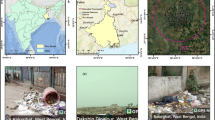Abstract
Improving real-time monitoring technologies introduces new tasks to the data analyst such as rapid identification of contamination source locations based on the data collected from monitoring stations. In theory, this problem is an ill posed problem which has non-unique solutions due to the irreversible nature of contaminant transformation and transport processes. In this study, we propose a methodology that utilizes a classification routine which associates the observations on a contaminant spill with one or more of the candidate spill locations in the river network. This approach consists of a training step followed by a sequential elimination of the candidate spill locations which lead to the identification of potential spill locations. In this process the training of the monitoring system may require a significant simulation time. However, this is performed only once. The statistical elimination for the ranking of the candidate locations is a rapid process. The proposed methodology is applied to the Altamaha river system in the State of Georgia, USA. The results show that the proposed approach may be effectively used for the preliminary planning of the contaminant source investigation studies in complex river systems.
Similar content being viewed by others
References
Aral MM, Guan J (1996) Genetic algorithms in search of groundwater pollution sources. Adv Groundw Pollut Control Remediat 9:346–371
Aral MM, Guan JB et al. (2001) Identification of contaminant source location and release history in aquifers. J Hydrol Eng 6(3):225–234
Bagtzoglou AC, Baun SA (2005) Near real-time atmospheric contamination source identification by an optimization-based inverse method. Inverse Probl Sci Eng 13(3):241–259
Boano F, Revelli R et al. (2005) Source identification in river pollution problems: A geostatistical approach. Water Resour Res 41(7)
Brooks MC, Wise WR (2005) Quantifying uncertainty due to random errors for moment analyses of breakthrough curves. J Hydrol 303(1–4):165–175
Datta B, Peralta RC (1986) Expert pattern recognition for pollution source identification. In: Karamouz M, Baumli GR, Brick WJ (eds) Water Forum ’86, vol 1. ASCE, New York, pp 195–202
Gorelick SM, Evans B et al. (1983) Identifying sources of groundwater pollution—an optimization approach. Water Resour Res 19(3):779–790
Grubner O (1971) Interpretation of asymmetric curves in linear chromatography. Anal Chem 43(14):1934–1937
Guan JB, Aral MM et al. (2006) Identification of contaminant sources in water distribution systems using simulation-optimization method: A case study. ASCE J Water Resour Plan Manag 132(4):252–262
Gunduz O, Aral MM (2003a) Hydrologic modeling of the lower Altamaha river basin. In: 2003 Georgia water resources conference, Athens, Georgia, University of Georgia
Gunduz O, Aral MM (2003b) A simultaneous solution approach for coupled surface and subsurface flow modeling. Atlanta, GA, MESL, CEE, Georgia Institute of Technology. MESL-02-03: 98
Jiang H (2008) Adaptive feature selection in pattern recognition and ultra-wideband radar signal analysis. PhD, Pasadena, California, California Institute of Technology, 10–31
Keats A, Yee E et al. (2007) Bayesian inference for source determination with applications to a complex urban environment. Atmos Environ 41(3):465–479
Liu X, Zhai Z (2008) Location identification for indoor instantaneous point contaminant source by probability-based inverse computational fluid dynamics modeling. Indoor Air 18(1):2–11
Liu X, Zhai Z (2009) Prompt tracking of indoor airborne contaminant source location with probability-based inverse multi-zone modeling. Build Environ 44(6):1135–1143
NCDC (2009) NNDC climate data online. http://www7.ncdc.noaa.gov/CDO/cdo
Neupauer RM, Lin RH (2006) Identifying sources of a conservative groundwater contaminant using backward probabilities conditioned on measured concentrations. Water Resour Res 42(3)
Neupauer RM, Wilson JL (1999) Adjoint method for obtaining backward-in-time location and travel time probabilities of a conservative groundwater contaminant. Water Resour Res 35(11):3389–3398
Neupauer RM, Wilson JL (2001) Adjoint-derived location and travel time probabilities for a multidimensional groundwater system. Water Resour Res 37(6):1657–1668
Neupauer RM, Wilson JL (2004) Numerical implementation of a backward probabilistic model of ground water contamination. Ground Water 42(2):175–189
Rossman LA (2007) Storm water management model user’s manual version 5.0. Cincinnati, OH, National Risk Management Research Laboratory, US Environmental Protection Agency
Shannon CE (1948) A mathematical theory of communication. Bell Syst Tech J 27(4):623–656
Singh RM, Datta B (2006) Identification of groundwater pollution sources using GA-based linked simulation optimization model. J Hydrol Eng 11(2):101–109
Singh RM, Datta B (2007) Artificial neural network modeling for identification of unknown pollution sources in groundwater with partially missing concentration observation data. Water Resour Manag 21(3):557–572
Singh RM, Datta B et al. (2004) Identification of unknown groundwater pollution sources using artificial neural networks. ASCE J Water Resour Plan Manag 130(6):506–514
Sun AY (2007) A robust geostatistical approach to contaminant source identification. Water Resour Res 43(2)
Sun AY, Painter SL et al. (2006) A robust approach for iterative contaminant source location and release history recovery. J Contam Hydrol 88(3–4):181–196
Telci IT, Nam K et al. (2008) Real time optimal monitoring network design in river networks. In: World environmental & water resources congress 2008, Honolulu, Hawaii
Telci IT, Nam K et al. (2009) Optimal water quality monitoring network design for river systems. J Environ Manag 90(10):2987–2998
USGS (2008) The national map seamless server. http://seamless.usgs.gov/
Author information
Authors and Affiliations
Corresponding author
Rights and permissions
About this article
Cite this article
Telci, I.T., Aral, M.M. Contaminant Source Location Identification in River Networks Using Water Quality Monitoring Systems for Exposure Analysis. Water Qual Expo Health 2, 205–218 (2011). https://doi.org/10.1007/s12403-011-0039-6
Received:
Revised:
Accepted:
Published:
Issue Date:
DOI: https://doi.org/10.1007/s12403-011-0039-6




